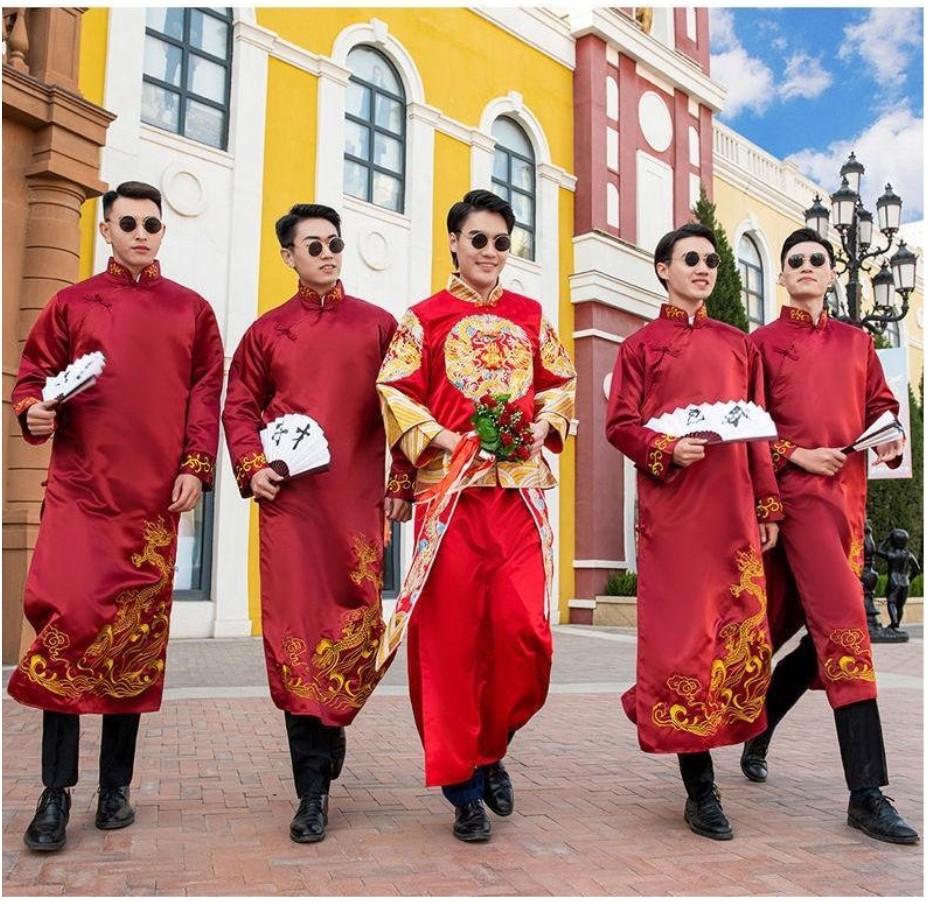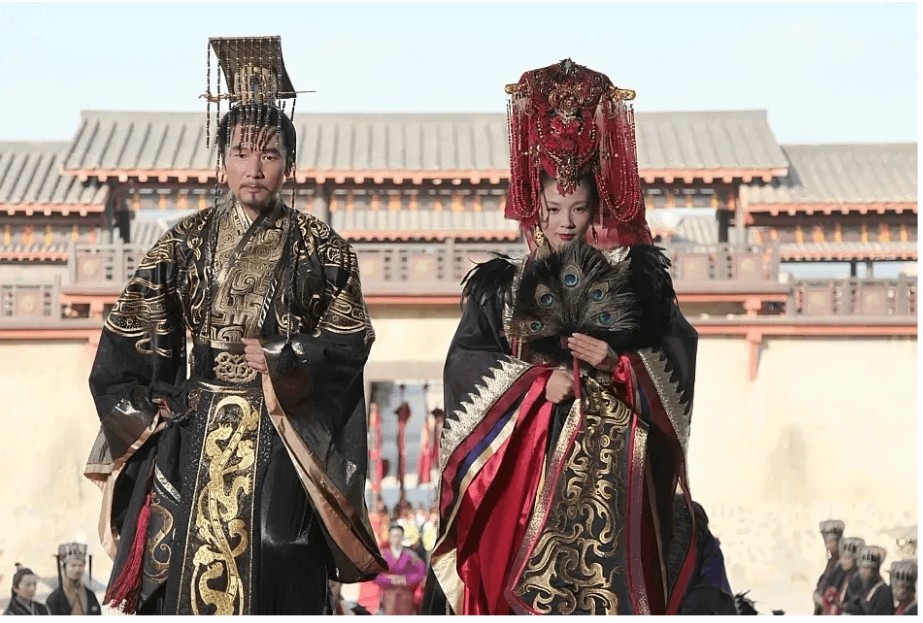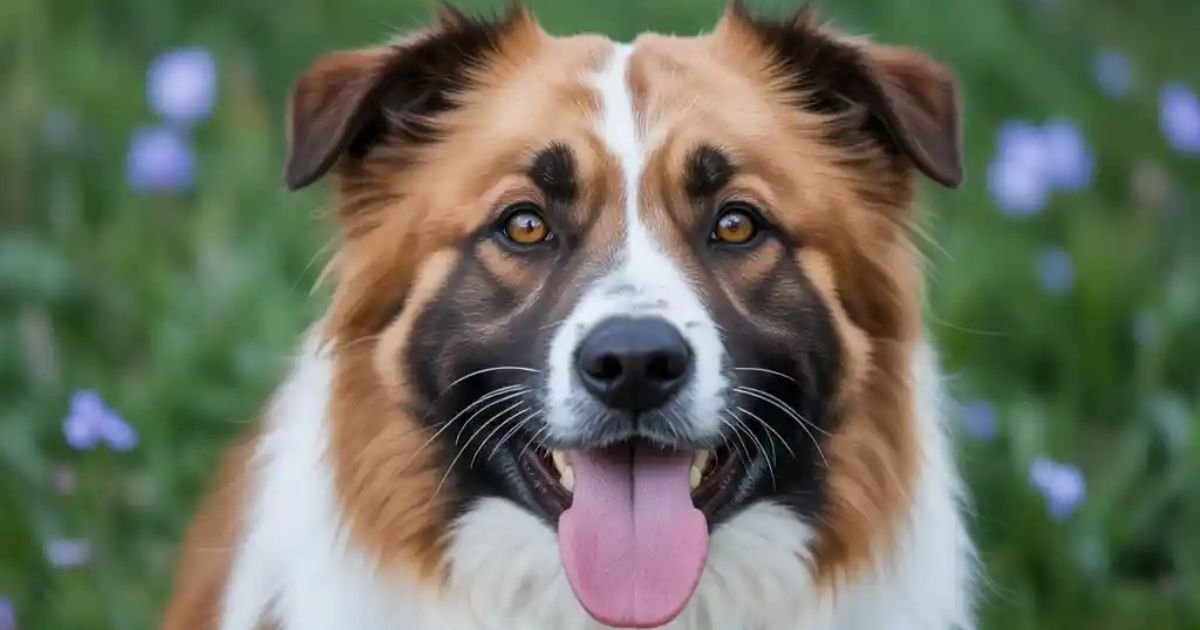The Tang Suit, an iconic symbol of Chinese heritage, has long been cherished for its traditional significance, stylistic versatility, and enduring appeal in modern fashion. Originating from the garments worn during the Qing Dynasty, the Tang Suit has evolved yet retains its deeply rooted cultural essence.
Overview of the Tang Suit
- Historical Origins: The Tang Suit is often misnamed. As some might assume, it did not originate from the Tang Dynasty but rather was popularized during the late Qing Dynasty. Its design was influenced heavily by the Manchu’s Magua, a horse-riding jacket. Over the years, this attire has become a staple for festive occasions and cultural celebrations.
- Design Evolution: Initially a symbol of male aristocracy, the Tang Suit has transcended gender boundaries and generational divides. Today, men’s tang suit designs are paired seamlessly with contemporary fashion elements, while women’s tang suits often feature modern twists that respect traditional aesthetics while catering to modern tastes.
Importance in Modern Culture
- Cultural Resurgence: In recent years, there has been a significant resurgence in wearing Tang Suits at public events and private celebrations, such as weddings and festivals. This renaissance is not just about fashion but is a nod to a renewed pride in Chinese cultural identity.
- Symbol of Fashion and Pride: Beyond traditional wear, Tang Suits are increasingly seen in global fashion arenas, where modern tang suit designs showcase a blend of East meets West. Designers are innovating these traditional garments to appeal to a global audience, integrating traditional Chinese attire with cutting-edge fashion trends.
- Jinza Oriental’s Role: As a custodian of Chinese sartorial heritage, Jinza Oriental plays a pivotal role in this cultural preservation. By crafting custom tang suits that maintain the essence of traditional design while infusing modern aesthetics, Jinza Oriental is at the forefront of bringing these cultural icons to the contemporary global stage.
The Evolution of the Tang Suit
The Tang Suit is a compelling chronicle of Chinese fashion. It evolved from imperial robes to a staple of modern wardrobes, embodying a unique blend of history and contemporary relevance.
Traditional Roots
- Historical Influence: The genesis of the Tang Suit can be traced back to the Magua, a Manchurian horseman’s jacket adapted during the Qing Dynasty. This garment initially served practical purposes for easier movement and warmth but gradually became a ceremonial staple in Chinese culture.
- Cultural Significance: Over the centuries, elements of various dynastic eras have woven their way into the Tang Suit, making it a rich tapestry of traditional Chinese attire. Its standing collar, knotted buttons, and sleek silhouette echo Confucianism’s philosophical and aesthetic ideals, representing order, discipline, and elegance.
- Contrasts with Qipao: Unlike the qipao, which is form-fitting and often associated with female attire, the Tang Suit offers a more relaxed fit and is traditionally more associated with male attire. However, modern iterations have seen the Tang Suit adopted by all genders, showcasing its versatility.
Modern Tang Suit Designs
- Contemporary Adaptations: Today’s Tang Suits blend traditional aesthetics with modern fashion needs. Designers are reimagining this historic garment with modern tang suit designs that appeal to a global audience, integrating fabrics like lightweight silk and patterns that push beyond the conventional.
- Innovative Features: Custom tang suits often feature adaptations such as slim-cut styles, vibrant color palettes, and even hybrid forms that merge Tang Suit elements with Western suit characteristics. These innovations make the Tang Suit relevant for various occasions, from casual wear to formal events like weddings.
- Cultural and Fashion Fusion: The modern Tang Suit respects its roots and embraces global fashion trends. This fusion makes it a popular choice for those looking to make a cultural statement while keeping up with contemporary fashion trends. Wedding tang suits, for example, are increasingly chosen for their unique blend of tradition and modernity, offering a culturally rich alternative to conventional wedding attire.
Designing Custom Tang Suits
Custom Tang Suits represent a unique intersection of traditional craftsmanship and modern fashion sensibilities. They allow wearers to express individual identity while honoring cultural heritage. Here’s how the process unfolds, from the initial idea to the final product.
Customization Process
- Initial Consultation: The journey begins with a personal consultation, during which clients express their vision, preferences, and the significance behind their custom tang suit. This step is crucial for understanding the purpose, whether for a wedding tang suit or a formal event piece.
- Design Selection: Clients choose from various designs, which can be traditional or incorporate modern tang suit designs. This includes selecting the silhouette, length, and key features that will make the suit a true reflection of their style.
- Fabric Selection: Selecting the right fabric is pivotal. Options usually include high-quality silk, brocade, or satin, offering different textures and levels of comfort. The choice often reflects personal taste and the practicality of the event’s setting.
- Color Choices: Colors are chosen not just for aesthetic appeal but for their symbolism within Chinese traditional attire. Red, for instance, is chosen for its auspicious qualities, while darker colors like blue and black might be selected for more subdued elegance.
- Personalization through Embroidery: Embroidery is a critical aspect, often involving intricate designs of dragons, phoenixes, or floral patterns, each carrying deep symbolic meanings. Clients can also opt for custom motifs with familial symbols or personal stories.
- Fitting Sessions: Multiple fittings may be required to ensure the tang suit fits perfectly. This is especially important for wedding tang suits, where comfort and appearance must seamlessly blend for a day-long event.
- Final Adjustments and Delivery: The final adjustments are based on the fitting feedback, ensuring every seam, button, and stitch complements the wearer’s physique and preferences. The final product is a masterpiece of personal expression and cultural artisanship.
Modern vs. Traditional Elements
- Traditional Techniques: Constructing a tang suit often utilizes age-old techniques passed down through generations, ensuring each piece is steeped in tradition. This includes traditional closures like frog buttons and mandarin collars.
- Modern Innovations: Contemporary designs may tweak traditional forms, introducing lower hemlines, streamlined silhouettes, or even integrating elements like zippers for ease of use. Fabrics might also include modern blends that offer durability and comfort without sacrificing the texture.
- Blending the Old and the New: The true artistry in creating custom tang suits today lies in balancing old-world charm with contemporary needs. This might mean making a suit that fits traditional wedding protocols but also stands out in a modern celebration setting.
This detailed approach respects the rich heritage behind the Tang Suit and embraces the wearer’s unique personal narrative, creating timeless and timely garments ideally suited for modern ceremonial needs. Check out Jinza Oriental on Instagram @jinzaoriental for insights and examples of beautifully tailored Tang Suits.
Craftsmanship and Material Selection
Creating a custom tang suit requires skill, precision, and a deep understanding of the materials and techniques that honor the tradition while catering to modern tastes. Here’s a deeper look into the fabric choices and craftsmanship that go into making these remarkable garments.
Fabric Choices
- Silk: The most commonly used fabric for tang suits, silk represents luxury and comfort, which is crucial for both men’s and women’s suits. Its natural luster and smooth texture make it a preferred choice for weddings and formal events.
- Brocade: Often chosen for more opulent designs, brocade features raised designs incorporated during the weaving process, usually with metallic threads. It is ideal for those seeking a more ornate appearance.
- Linen and Cotton: For those looking for comfort, especially in warmer climates, linen and cotton offer breathability and ease without compromising the suit’s formal appearance.
- Blended Fabrics: Modern tang suit designs might include blended fabrics that combine traditional aesthetics with synthetic fibers’ durability and ease of maintenance.
Tang Suit Craftsmanship
- Embroidery: This is where the artistry shines in creating a Chinese traditional tang suit. Embroidery in tang suits can include everything from simple monochromatic threads to vibrant, multicolored designs featuring historical and mythological motifs such as dragons, phoenixes, or floral patterns.
- Button Making: Traditional tang suits feature Chinese frog buttons, knotted buttons that serve both functional and decorative purposes. Making these buttons requires precise handwork, which is often a hallmark of quality in custom tang suits.
- Tailoring Techniques: Constructing a tang suit is a meticulous process requiring great precision. Tailors must have a thorough understanding of traditional cutting and sewing techniques to ensure the suit fits perfectly and maintains its classic form.
- Finishing Touches: Final touches might include piping, lining, and edge stitching, which enhance the garment’s beauty and durability. These elements are critical in ensuring a tang suit stands out for its detailed craftsmanship and elegance.
The combination of premium fabrics and meticulous craftsmanship ensures that every tang suit produced is not only a piece of clothing but a masterpiece of cultural art.
Tang Suit in Multicultural Weddings
Wedding Tang Suits are more than just garments; they are a vibrant expression of cultural heritage that can be beautifully woven into the fabric of multicultural celebrations. Here’s how these traditional outfits make a unique statement in modern weddings.
Wedding Tang Suits
- Symbolic Integration: Incorporating a wedding tang suit into a marriage ceremony is a powerful way to honor one’s cultural heritage. Whether the groom or other family members donning these suits, each piece nods to traditional values and aesthetics.
- Design Adaptation: Modern tang suit designs have evolved to suit contemporary tastes while keeping traditional motifs alive. This adaptation makes tang suits appealing not just to those of Chinese descent but also to anyone wanting to add a touch of solemn history to their celebration.
- Personal Style Expression: Couples are increasingly choosing custom tang suits to reflect their personal style. Each suit is tailored to tell a personal story or symbolize a unique blend of cultural identities by customizing everything from the fabric to the cut and embellishments.
Multicultural Celebrations

- Cultural Fusion: In weddings that blend cultures, tang suits offer a visually striking element that complements other cultural attires. It’s not uncommon to see a groom in a tang suit standing next to a bride in a Western gown or another traditional dress, showcasing a respectful and beautiful union of backgrounds.
- Customization for Everyone: Tang suits for women and men are highly customizable, allowing couples to coordinate elements of their outfits with each other and the wedding theme itself. This makes tang suits versatile for various ceremonial roles and festivities.
- Inclusive Celebrations: By incorporating tang suits, weddings become a platform for educating guests about Chinese culture and celebrating the inclusivity of different traditions coming together. This attire choice can lead to enriched understanding and appreciation among all attendees.
Tang Suit vs. Qipao
Tang Suit and Qipao represent profound symbols in Chinese cultural attire, each with distinct charm and significance. Choosing between these two for occasions like a Chinese Tea Ceremony involves understanding their unique attributes and how they can complement each other, especially when aiming to create a harmonized aesthetic for both bride and groom.
Comparative Analysis
- Occasion Suitability: The Tang Suit is often favored for its formal and masculine appeal, making it a popular choice for grooms during wedding ceremonies, especially Chinese Tea Ceremonies. On the other hand, the Qipao is celebrated for its feminine elegance and grace, often chosen by brides for its figure-enhancing silhouette.
- Design and Customization: Both garments offer extensive customization options. For the Tang Suit, adding personal touches, such as a lining that matches the bride’s Qipao silk color, can create a subtle yet beautiful connection between the couple’s outfits. Custom embroideries incorporating meaningful symbols, such as the double happiness character or elements representing the couple’s zodiac signs, can also be added to both outfits to symbolize the union and shared future.
- Symbolism and Tradition: In traditional Chinese weddings, the Tang Suit and the Qipao carry rich symbolism through their colors and designs. Red, commonly used in both, symbolizes good luck and joy, and is often the color of choice for weddings. Integrating such symbolic elements is crucial, particularly in the Tang Suit for men, as it reflects respect and appreciation for cultural heritage.
- Tea Ceremony Specifics: During a tea ceremony, where respect and tradition play pivotal roles, the Tang Suit and the Qipao can be tailored to reflect shared aesthetics. For instance, matching the color palette or incorporating complementary embroidery across both garments enhances the visual and thematic cohesion of the event, making the ceremony not only a union of two people but also a celebration of shared cultural values.
By choosing either a Tang Suit or a Qipao, or even creatively pairing elements of both, couples can make a powerful statement about their style while deeply honoring their heritage. This choice allows them to celebrate their big day with a profound sense of identity and cultural pride, fully embraced by the meticulous craftsmanship offered by Jinza Oriental.
Jinza Oriental’s Commitment to Tradition and Innovation
Jinza Oriental stands at the forefront of bridging centuries-old traditions with contemporary fashion through its expert crafting of custom tang suits. This commitment preserves and revitalizes a rich heritage, making it relevant for today’s diverse and discerning clientele.
Jinza Oriental’s Expertise
- Heritage and Innovation: At Jinza Oriental, the timeless art of Tang Suit craftsmanship is honored and upheld through each garment. The team meticulously blends traditional techniques with modern innovations, ensuring that every suit is authentically Chinese and refreshingly contemporary.
- Quality and Detail: Jinza Oriental’s dedication to quality is evident in the choice of fabrics and attention to detail. Using only the finest materials, such as silk and brocade, Jinza Oriental ensures that each Tang Suit not only looks magnificent but also feels luxurious.
Bespoke Services
- Tailored to Perfection: Understanding that each client is unique, Jinza Oriental offers bespoke tailoring services for extensive customization. Whether it’s a wedding tang suit or a piece for a special cultural event, clients can influence every aspect of their suit—from fabric choice to intricate embroidery details.
- Cultural Connection: Each Tang Suit is crafted with a deep respect for cultural heritage. Clients are invited to infuse personal and familial symbols into their designs, making each garment a personal heirloom and a story of their heritage.
- Discover and Design: We invite you to visit Jinza Oriental and explore the rich possibilities within the world of traditional Chinese attire. Engage with our designers to craft a Tang Suit that perfectly matches your aesthetic and cultural expectations.
- Celebrate Your Heritage: Let us help you celebrate your special day or significant event with a garment that is as meaningful as it is beautiful. Step into Jinza Oriental and embrace the perfect blend of tradition and modern style crafted just for you.
Jinza Oriental is not just about clothing; it’s about embracing and celebrating cultural identity with every stitch and seam.





